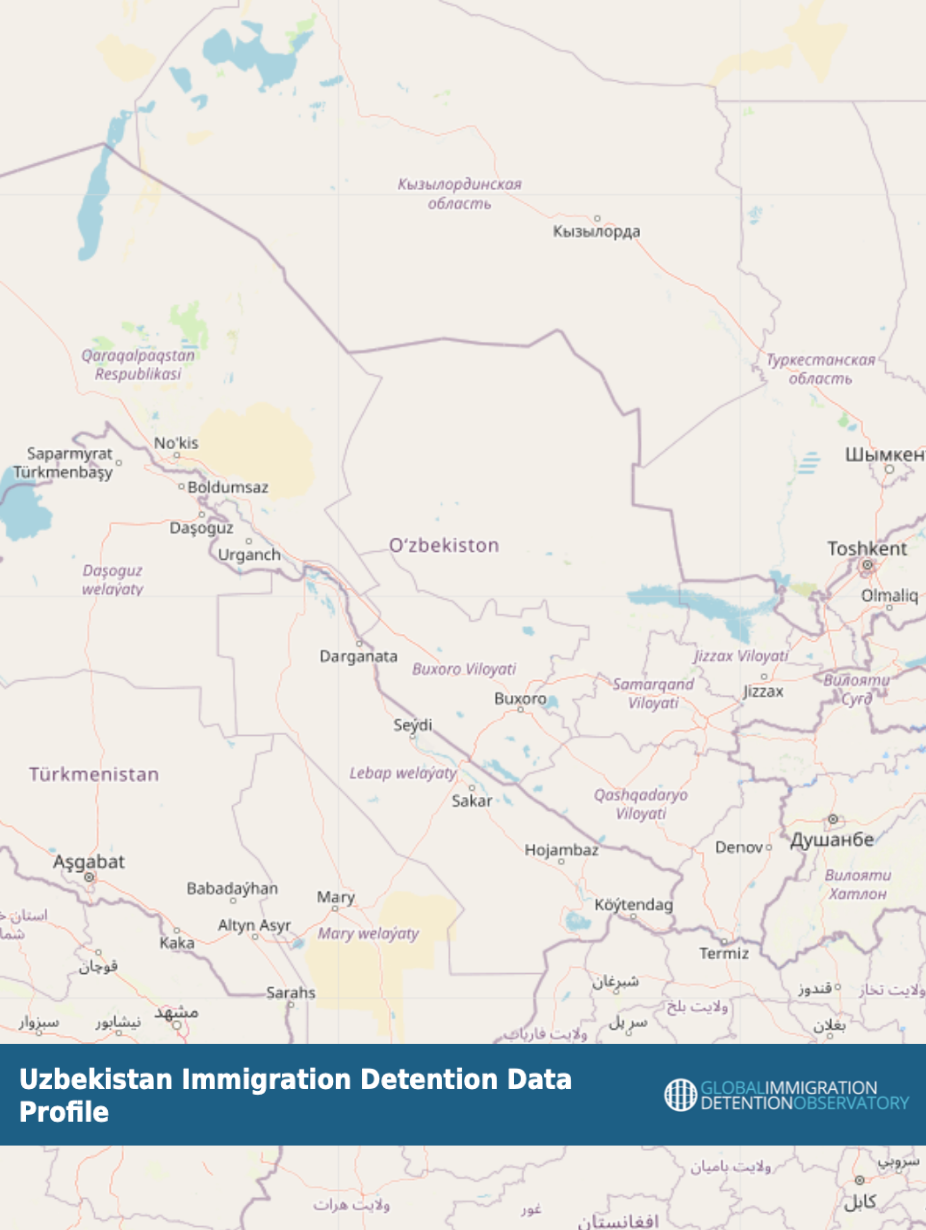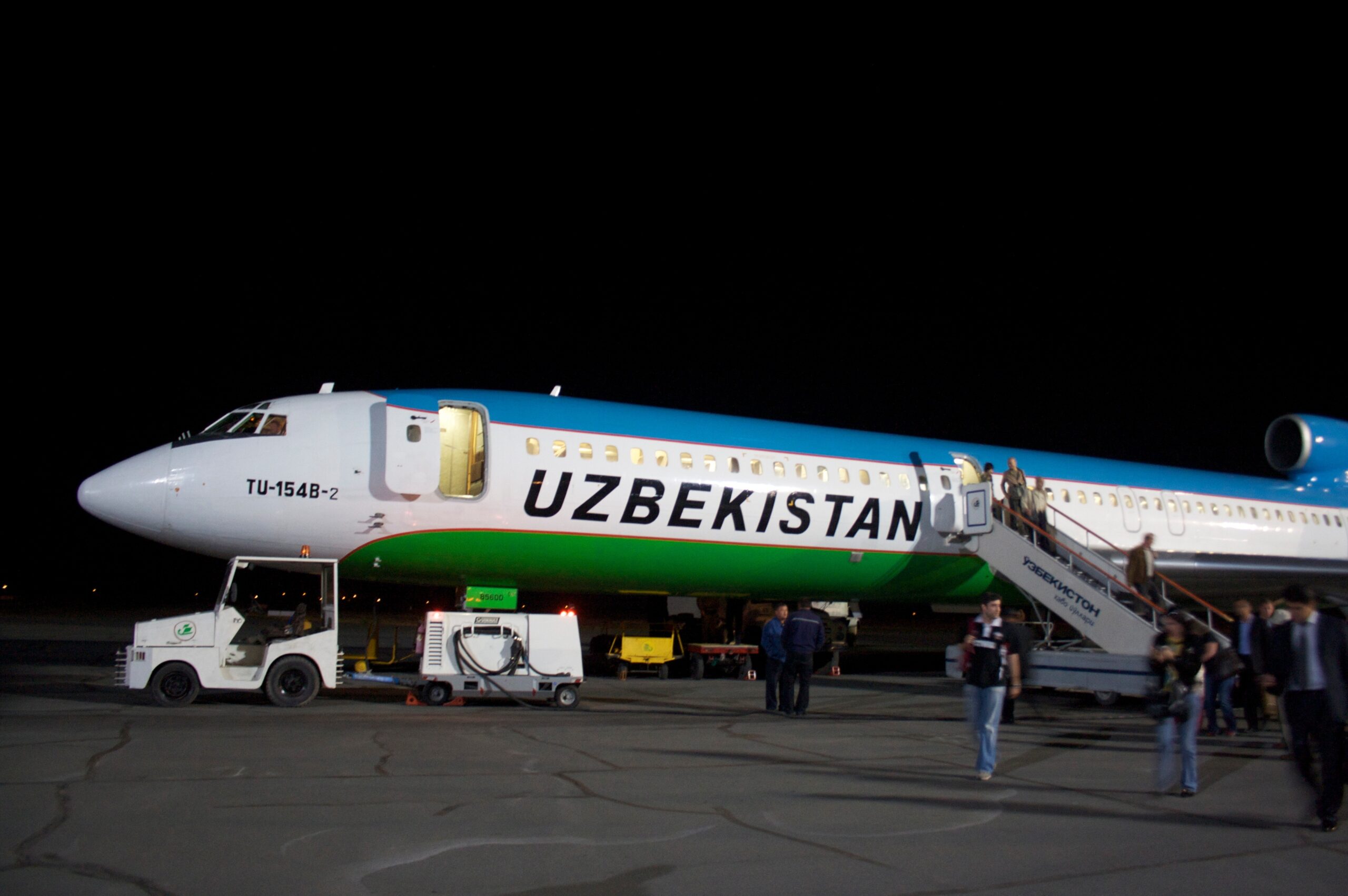Uzbekistan’s immigration laws and practices have received little international attention. However, new arrangements with both the European Union and the United States are raising questions about the country’s commitments to its human rights obligations. […]
Read More…
Prior to the pandemic, between two and three million Uzbek nationals worked overseas–primarily in Russia, as well as in countries such as Kazakhstan, Turkey, South Korea, and the United Arab Emirates. Hard-hit by the repercussions of the pandemic and with many losing their sources of employment, significant numbers of Uzbek migrant workers have sought to […]
Read More…
Last updated: July 2024
DETENTION CAPACITY
ALTERNATIVES TO DETENTION
ADDITIONAL ENFORCEMENT DATA
SOCIO-ECONOMIC DATA & POLLS
Name
Year Adopted
Last Amended
Criminal Code of the Republic of Uzbekistan
1994
The Administrative Responsibility Code of the Republic of Uzbekistan
1994
2020
Law on the Legal Status of Foreign Citizens and Stateless Persons in the Republic of Uzbekistan
2021
Grounds for Incarceration
Maximum n. of Days
Year
INTERNATIONAL TREATIES & TREATY BODIES
Ratification Year
Observation Date
CEDAW, Convention on the Elimination of All Forms of Discrimination against Women
1995
2017
VCCR, Vienna Convention on Consular Relations
1992
2017
ICERD, International Convention on the Elimination of All Forms of Racial Discrimination
1995
2017
ICESCR, International Covenant on Economic, Social and Cultural Rights
1995
2017
ICCPR, International Covenant on Civil and Political Rights
1995
2017
CAT, Convention against Torture and Other Cruel, Inhuman or Degrading Treatment or Punishment
1995
2017
CRC, Convention on the Rights of the Child
1994
2017
CTOCTP, Protocol to Prevent, Suppress and Punish Trafficking in Persons, Especially Women and Children
2008
2017
ICCPR, First Optional Protocol to the International Covenant on Civil and Political Rights, 1966
1995
1995
Recommendation Year
Observation Date
Committee on the Rights of the Child
44. the Committee recommends that the State party:
(a) Establish a national system for international protection, including for children, with safeguards against arbitrary detention, deportation and refoulement;
(b) Prohibit all detention of children for migration-related reasons, including of unaccompanied children;
(c) Recognize and provide legal status to refugees and asylum-seeking families, including children;
(d) Facilitate access for asylum-seeking and refugee children to education, health care and social services;
(e) Consider ratifying the 1951 Convention relating to the Status of Refugees and its 1967 Protocol.
2022
2022
2022
Human Rights Committee
§41. The State party should establish a comprehensive national asylum system that is in conformity with international standards and that guarantees access to the territory and to asylum procedures to all persons in need of international protection, and that also provides for adequate safeguards against arbitrary detention, deportation and refoulement. The State party should also ensure that current citizenship legislation provides adequate safeguards for the prevention of statelessness in compliance with international standards. The Committee also encourages the State party to accede to the 1951 Convention relating to the Status of Refugees and its 1967 Protocol, to the 1954 Convention relating to the Status of Stateless Persons and to the 1961 Convention on the Reduction of Statelessness.
2020
2020
Committee on the Rights of the Child
§ 62. "The Committee recommends that the State party:
(a) Ensure that its laws and procedures fully respect the principle of non-refoulement in accordance with international refugee and human rights standards and abandon the practice of forcibly returning child refugees and asylum seekers and their families to their countries of origin where there is a risk of their being subject to torture or persecution;
(b) Consider extending a temporary protection regime to child refugees and their families in Uzbekistan who are unable and/or unwilling to return to their country of origin and whose third country resettlement applications have been rejected multiple times, inter alia through the provision of residence and work permits;
(c) Consider granting legal status and an opportunity for local integration to mandate refugees who have been married to Uzbek nationals, and whose children were born in, and are citizens of, Uzbekistan; and,
(d) Consider reopening the United Nations High Commissioner for Refugees ( UNHCR ) office in its territory and consider acceding to the 1951 Convention relating to the Status of Refugees and its 1967 Protocol, the 1954 Convention relating to the Status of Stateless Persons and the 1961 Convention on the Reduction of Statelessness."
2013
2013
> UN Special Procedures
Year of Visit
Observation Date
Special Rapporteur on the promotion and protection of human rights while countering terrorism
2021
2021
2021
> UN Universal Periodic Review
> Global Compact for Migration (GCM)
> Global Compact on Refugees (GCR)
REGIONAL HUMAN RIGHTS MECHANISMS
HEALTH CARE PROVISION
HEALTH IMPACTS
COVID-19
Prior to the pandemic, between two and three million Uzbek nationals worked overseas--primarily in Russia, as well as in countries such as Kazakhstan, Turkey, South Korea, and the United Arab Emirates. Hard-hit by the repercussions of the pandemic and with many losing their sources of employment, significant numbers of Uzbek migrant workers have sought to return home.
While former Uzbek president Karimov was notoriously disdainful towards Uzbek labour migrants--“Those people who go to Moscow to clean the streets are just lazybones” he stated in June 2013--current president Mirziyoyev has adopted a more favourable stance, appreciating labor migrants’ importance to the Uzbek economy. His government won praise from some for its work assisting stranded migrants to return home during the pandemic (arranging several repatriation flights, trains, and buses). According to Uzbekistan’s Deputy Labour Minister, at least 500,000 had returned as of 29 May, with more returning since. On 21 September, the country’s Ministry of Transport reported that it had arranged for a further 1,800 migrant workers to be returned by train from Samara and Novosibirsk.
On the other hand, Human Rights Watch (HRW) has said that the government’s efforts to repatriate migrant workers have been, at best, erratic, with many thousands remaining trapped outside the country’s borders. Many have been forced to camp out at airports in Russia (see our 24 July Russia update on this platform). Others have attempted to return by bus or car through Russia, often having to spend time in makeshift camps at the Russia-Kazakhstan border as they await transport and permission to cross.
One such camp, near the Kinel train station in Samara Oblast, is designed for 900 people. However, according to HRW, in September some 4,000 migrants, including at least 43 children, were stuck there. No medical care is reported to be available in the camp, and persons are not tested for COVID-19. Journalists from Novaya Gazeta, who visited the camp in September, allege that the camp management has sought to prevent camp residents from speaking to the media about the conditions they face. An additional camp has also been established in Kamensk-Shakhtinsky (Rostov Oblast), from where occasional trains leave for Uzbekistan.
With Covid infection rates significantly higher in labour migration destinations such as Russia than in Uzbekistan, persons who have managed to return have faced quarantine in hastily-erected state run facilities--some of which are no more than cargo containers placed together in rows. In the largest reported site--the “Urtasary” facility in the Tashkent region--3,467 containers were placed together, each containing four beds. In July, the facility was the site of protests, as returnees demanded their release from the carceral-style facility. According to the Uzbek Forum for Human Rights, some had been held for more than 30 days without any explanation, far exceeding the recommended 14-day quarantine period. In a video shared by Ozodlik (RFE/RL’s Uzbek service), detainees penned into the camp by iron fencing can be seen calling for their release. Allegations of police brutality also surfaced, and one returnee is reported to have committed suicide following his placement in the facility. The Uzbek Forum for Human Rights has confirmed to the GDP, however, that the Urtasary facility is now closed. Returning migrants are instead instructed to quarantine in their own homes.
Unknown
(Unknown)
Unknown
Unknown
Unknown
Unknown
(Included)
Unknown
Included
Included





